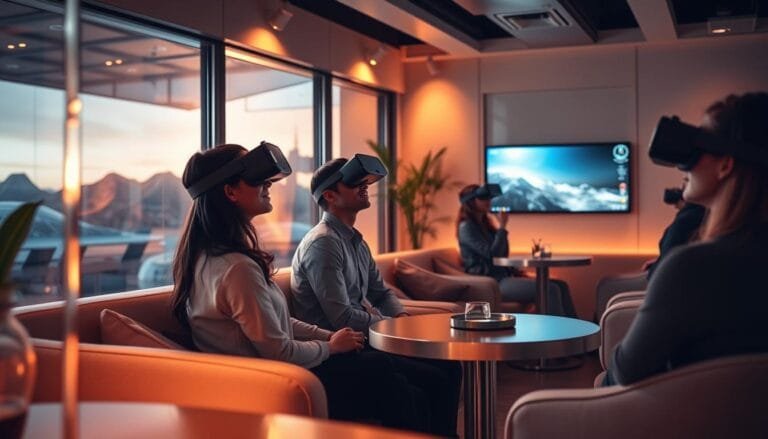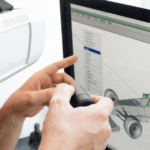Step into worlds that feel alive. This roundup gathers standout titles across Meta Quest, PlayStation VR2, and PC VR to help you find a great fit for how you like to play. Whether you want quick rhythm flow or long narrative journeys, the right pick makes every session matter.
On Quest 3, several releases get meaningful boosts: 120Hz support for Beat Saber, mixed reality for Cubism and Puzzling Places, and higher-res updates for Population: One. Batman: Arkham Shadow won UploadVR’s Game of the Year 2024 and now includes New Game+, added challenges, and an Extreme difficulty.
Other highlights include Asgard’s Wrath 2’s enhanced graphics mode, Arizona Sunshine 2’s full co-op campaign and canine companion Buddy, and Demeo’s free campaigns plus mixed-reality hand tracking. Eye of the Temple delivers near-total real-world locomotion and asks for at least a 2m x 2m play area. Metro Awakening supports cross-buy with Rift and offers a PC VR edition.
Key Takeaways
- This list helps you pick the best games for your play style and setup.
- Quest 3 upgrades bring smoother refresh rates and mixed-reality features.
- Story, co-op, and sim titles all receive meaningful post-launch support.
- Movement options and onboarding make long sessions more comfortable.
- Cross-buy and platform parity mean your choice can work across systems.
What makes a good VR game right now
Immersion grows from simple systems that let you act without thinking. When controls teach through play and movement maps to intent, players stay in the moment. That first sense of presence is the way a title earns repeat sessions.
Immersion, comfort, and intuitive movement
- Clear onboarding that teaches by doing helps players feel confident fast.
- Comfort options — snap turn, seated modes, and room-scale play — reduce nausea and extend session length.
- Smart movement blends physical steps, head-directed locomotion, and context-aware actions for minimal disorientation.
- Graphics and visuals should support presence: readable scenes, stable frame pacing, and tidy rendering.
- Higher refresh rates like 120Hz on Quest 3 make rhythm and action feel responsive and fluid.
- Mixed reality and hand tracking let puzzling and tabletop play fit your real environment with natural interaction.
At the right level, design meets players where they are. Good interfaces, generous checkpoints, and sensory feedback keep the experience grounded and welcoming.
Editor’s criteria and how we test at the present moment
We test to find experiences that hold up after dozens of sessions and across platforms. Our goal is to judge how titles perform in real-world play, not just in short demos.
We play each release on multiple headsets and note differences in tracking, haptics, and framerate. This lets us report which system gives the best visuals or tactile feedback.
Updates, DLC, and post-release support that elevate value
Post-launch content can change a title’s trajectory over years. We track developer updates, DLC cadence, and community engagement to see if a title grows in value over time.
- We evaluate onboarding, comfort options, and controller tracking quality in varied play spaces.
- Stability tests measure crash frequency, tracking robustness, and sustained performance in long sessions.
- Score is contextual: a single review number does not replace who a title is for or how it fits your schedule.
- Value is judged by content amount, replay loops, and developer roadmaps—what you get after purchase matters most.
“Robust updates and clear developer communication often turn solid launches into long-term favorites.”
Best Meta Quest picks with mixed reality magic
On Meta Quest, a handful of standout titles turn mixed reality and higher refresh rates into instantly playable thrills. These picks highlight upgrades that make the headset vanish and play feel immediate.
Beat Saber and Pistol Whip for rhythm-fueled flow
Beat Saber uses a 120Hz boost on Quest 3 and keeps adding music packs from big artists. That makes sessions feel snappy and replayable.
Pistol Whip stays cinematic with new scenes and steady updates that keep motion tight and exciting.
Red Matter 2 and Asgard’s Wrath 2 for next-level visuals
Red Matter 2 on Quest 3 brings higher rendering resolution, 4K textures, and dynamic shadows for striking sci-fi environments.
Asgard’s Wrath 2 adds an enhanced graphics mode and event-driven content that raises its epic moments.
Cubism and Puzzling Places with standout mixed reality and hand tracking
Cubism and Puzzling Places slide into your room via mixed reality and hand tracking. Puzzling Places also delivers monthly puzzle packs to refresh content.
Demeo and Dungeons of Eternity for co-op adventure
Demeo offers free campaigns, MR, hand tracking, and colocation to make tabletop nights social and tactile.
Dungeons of Eternity focuses on polished co-op with a solid progression loop for longer sessions.
Population: One and Arizona Sunshine 2 for competitive and co-op action
Population: One runs at 90FPS with boosted LOD on Quest 3, keeping competitive matches smooth.
Arizona Sunshine 2 delivers two-player co-op and even a canine sidekick, balancing tension and humor.
“Across these picks, targeted upgrades and ongoing support prove how standalone platforms can deliver standout moments.”
PlayStation VR2 standouts for console-grade immersion
When console polish meets headset-first design, familiar worlds read as fresh and immediate. Sony’s platform is where cinematic series gain tactile nuance and careful comfort options. These releases highlight why a premium console experience matters.
Resident Evil Village and Resident Evil 7 for iconic survival horror
Resident Evil Village on PlayStation VR2 adds richly detailed levels, tactile reloading, and gear upgrades that make encounters feel brutal and precise.
Resident Evil 7 remains a benchmark for claustrophobic tension and immersive horror designed for head-mounted play.
Batman: Arkham Shadow and Assassin’s Creed Nexus for blockbuster campaigns
Batman: Arkham Shadow leans into post-launch support with New Game+, an Extreme difficulty, and extra challenges that extend replay value.
Assassin’s Creed Nexus delivers roughly a 20-hour campaign that translates stealth, parkour, and combat into first-person moments built to be lived in.
Moss and Astro Bot Rescue Mission for charming platform adventures
Moss and Astro Bot use third-person perspective and PlayStation hardware strengths for comfort and charm. They create diorama-style levels and intuitive controls that invite players of all ages.
“Sony’s headset brings crisp visuals and nuanced haptics that elevate presence, adding subtle cues to every footstep, impact, and environmental beat.”
- PS VR2 shines when big franchises embrace headset strengths and comfort options.
- Console-backed QA and platform support produce stable releases with thoughtful save systems.
- Post-release content and difficulty scaling give both newcomers and veterans reasons to revisit these worlds.
PC VR essentials that still set the bar
PC headsets and powerful GPUs let developers push fidelity and systems farther than other platforms. The result is tactile worlds where physics and direction matter for every interaction.
Half-Life: Alyx for flagship storytelling and physics
Half-Life: Alyx is built for immersive interaction. Advanced physics, meticulous pacing, and top-tier graphics show how narrative and tech align.
Blade and Sorcery and Metal Hellsinger VR for combat variety
Blade and Sorcery pairs weighty melee with wide mod support so players can tweak combat systems. Metal Hellsinger VR fuses rhythm and shooting for focused, high-energy sessions.
No Man’s Sky and Elite: Dangerous for vast exploration
No Man’s Sky’s VR mode turns discovery into a tactile ritual after years of updates. Elite: Dangerous rewards patience with a cockpit system that grows more intuitive over time.
Project Cars 2 for authentic racing sim thrills
Project Cars 2 delivers true-to-life driving with nuanced environmental effects and night handling. Fine-tune performance, streaming, and input to match your rig.
- Why PC matters: graphics, mods, and open ecosystems let players refine comfort and performance.
- Many titles keep evolving through patches and community tools from developers and modders.
- Reviews praise how precise direction and physics make small gestures feel meaningful.
“PC essentials continue to set the standard for depth, fidelity, and long-term value.”
Rhythm and movement: the best games to get you in the zone
Rhythm titles turn physical motion into a focused, energizing rush. They fit short sessions or long runs, and they reward practice with tangible improvement. Pick the control style that matches your body and mood, then let music guide your steps.
Beat Saber: fast, accessible, endlessly expandable
Beat Saber remains the first port of call for many players. On Quest 3 it runs at 120Hz and includes DLC from artists like Queen, Billie Eilish, and Metallica. Intuitive slashes and a massive library make it easy to jump in and chase a higher score while you sweat.
Pistol Whip: cinematic gun-fu to the beat
Pistol Whip turns movement into momentum. Ongoing updates add new content and features that keep levels fresh. The blend of shooting, dodging, and rhythmic pacing creates a cinematic workout that feels as good as it looks.
Maestro: hand-tracked conducting with classical flair
Maestro uses hand tracking to let you conduct with nuance. Paid DLC packs like “Doom Bound” and “Secret Sorcery” expand repertoire and challenge. This title offers a unique musical experience that rewards subtle control and timing.
- Fitness by play: these titles turn sweat into joy and respect movement as input.
- Accessibility: adjustable levels and comfort settings meet any energy or skill.
- Longevity: ongoing content drops and smart leaderboards keep you coming back—thanks to regular updates, playlists stay lively.
Story-driven adventures that redefine presence
Modern single-player tales blend hands-on interaction with cinematic pacing to deepen immersion. These releases show how careful design and clear direction make every moment matter.
Ghost Town and Eye of the Temple for inventive VR-first design
Ghost Town (2025) pairs investigative storytelling with tactile puzzles. The visuals and crisp graphics on Quest 3 make clues feel within reach.
Eye of the Temple asks for a 2m x 2m play area and uses real walking as traversal. This physical movement changes how the world reads and how tension builds.
Resident Evil 4 VR and Metro Awakening for tense narrative action
Resident Evil 4 on Quest adapts the full campaign with motion controls, later adding The Mercenaries mode. Actions like reloading and inventory feel hands-on.
Metro Awakening wraps stealth and firefights in dense atmosphere and supports cross-buy, so a single release stretches across standalone and PC setups.
Red Matter 2 for atmospheric sci-fi puzzle-solving
Red Matter 2’s Quest 3 update brings higher resolution and 4K textures. Its world-building and puzzles turn exploration into a cinematic, clarity-first experience.
“When story and mechanics align, you don’t just play—you live the tale.”
- Comfort options keep intensity manageable over time.
- Thoughtful interactions add real-life gestures to every scene.
- These titles give a clear reason to return when an hour or an evening opens up.
Co-op and social VR: play together, anywhere
Social play turns solo sessions into shared stories. Invite friends for a quick round or settle in for a long campaign and let teamwork do the rest.
Demeo and Demeo Battles for tabletop nights
Demeo recreates tabletop magic with painted minis and strategic turns. The title ships free campaign updates and supports mixed reality with hand tracking and colocation on Quest 3.
Demeo Battles trims the loop into tighter, competitive bursts. It’s a perfect pick when your group wants faster matches and high replay value.
Population: One for free-to-play battle royale
Population: One makes social competition feel physical with climbing and gliding. The free-to-play model on the Quest store plus cross-play and a steady 90FPS on modern headsets makes it easy to squad up across platforms.
Keep Talking and Nobody Explodes for party chaos
This title flips co-op into a communication exercise. One player defuses while others read manuals—timing and clear calls create laugh-out-loud tension that fits any party.
- Flexible sessions: jump into quick rounds when time is short, or run long campaigns on a free night.
- Accessibility: comfort settings and voice chat smooth coordination so everyone plays their way.
- Community growth: ongoing updates raise the amount of fresh content and help you find the right choice for your group.
“These titles make distance vanish—shared spaces and colocation blur home and table.”
Thanks to active communities and regular updates, social play is one of the best ways to keep friends connected and entertained.
Puzzle and chill: mindful experiences with stunning design
Quiet, tactile puzzles can turn a short break into a restorative ritual that resets focus and mood. These picks favor clarity and calm over spectacle, and they fit into short sessions or longer afternoons.
Cubism
Cubism pairs clean geometry with a gentle soundtrack and tactile controls. On Quest 3 it adds mixed reality, hand tracking, and 120Hz support so shapes feel immediate and responsive.
Puzzling Places
Puzzling Places uses photogrammetry to turn real landmarks into soothing dioramas. MR on Quest 3 lets you build on your desk, and monthly puzzle packs keep the environment fresh without friction.
I Expect You To Die
I Expect You To Die channels spycraft into clever escape-room scenes. Telekinesis and VR-optimized interactions reward observation and experimentation across platforms, and store listings and reviews often praise its steady pacing.
- Intuitive controls and clear feedback reduce friction so you stay in the moment.
- Visuals favor readability—minimalist or photoreal textures help you solve without strain.
- World details and ambient audio reward curiosity and make each session feel like a small life reset.
Whether you have ten minutes or an hour, these titles scale gracefully and offer a calm, mindful experience that slips easily into daily routines.
Mixed reality on Quest 3: where the real world meets VR
Quest 3’s mixed reality layer changes how you interact with virtual content. Hand tracking, better refresh rates, and spatial mapping make virtual pieces feel like they belong on your table.
Why MR upgrades, 120Hz support, and hand tracking matter
Mixed reality reduces setup friction and keeps your awareness of the room while you play. That lowers the barrier to entry and shortens the path from putting on the headset to actually enjoying a session.
Higher frame rates such as 120Hz in select titles make motion smoother and easier on the eyes. Hand tracking lets you pinch, grab, and point without controllers, which feels more natural for casual and social play.
Top MR-friendly picks: Cubism, Puzzling Places, Demeo
Cubism uses MR, hand tracking, and 120Hz to place tactile puzzles on real surfaces. The result is a mindful, fast-to-start experience that invites short sessions.
Puzzling Places maps photogrammetry dioramas onto desks and shelves, and monthly puzzle packs on the Quest Store keep content fresh without friction.
Demeo combines MR with colocation so friends can share the same physical board from different headsets. That makes game night feel social and grounded.
“MR isn’t a gimmick—it’s a new mode of presence that brings virtual layers into daily life.”
- MR reduces friction and supports quick play sessions.
- Performance and graphics upgrades keep virtual objects crisp and stable.
- The Meta Quest headset now serves both deep immersion and light-touch social tech.
Sports and sim realism: swing, drive, and soar
Simulated sports and vehicle sims deliver a satisfying mix of precision and presence. These titles reward steady practice and a tuned control system that teaches you by doing.
GOLF+ for relaxed multiplayer rounds
GOLF+ is a social staple with practice ranges, casual rounds, and new courses available via DLC or a subscription pass. Updated visuals and Meta Avatars on Quest bring a friendlier social layer to each match.
Project Cars 2 for cockpit authenticity
Project Cars 2 shines in headset cockpits where weather, track effects, and car setup demand focus. This title rewards fine tuning—braking points and grip changes feel immediate as you climb each level of skill.
Elite: Dangerous for deep-space sim fans
Elite: Dangerous turns your headset into a starship window. Complex ship systems create a steep learning curve, but mastering them opens a huge sandbox for exploration and long-form progression.
- Multiplayer and leaderboards add a friendly competitive edge.
- Solo practice and streaming-ready sessions fit varied schedules.
- Dynamic weather, day-night cycles, and nuanced physics give life to every run.
- Comfort tuning ensures a proper fit for long sessions in the cockpit or on the green.
“If you needed a reason to try a sim in virtual reality, this is it: precision, presence, and the quiet joy of mastery.”
Good VR game picks for first-time headset owners
New players should aim for experiences that prioritize comfort and clear feedback. The right first library helps you learn controls, build stamina, and fall in love with presence without overwhelming motion or menus.
Comfort-first starters: Beat Saber, Moss, Cubism
Beat Saber on Quest 3 runs at 120Hz, which boosts responsiveness and reduces motion strain. That makes it an ideal rhythm pick to build confidence.
Moss uses a gentle third-person viewpoint and clear checkpoints. Its charm and steady pacing keep sessions comfortable for new players.
Cubism offers mixed reality and hand tracking for low-friction puzzling. Short, satisfying puzzles make it easy to play in brief bursts while you learn controls.
Graduating to deeper worlds: Half-Life: Alyx, Red Matter 2
When you’re ready, step into titles that reward longer sessions and curiosity.
Half-Life: Alyx is widely praised for VR-native design and hands-on interaction. It teaches advanced gestures through play and delivers a rich narrative payoff.
Red Matter 2 brings Quest 3 visual boosts like 4K textures and dynamic shadows. Its atmospheric puzzles reward careful exploration and sustained attention.
- Start with 10–20 minute sessions and extend slowly as stamina grows.
- Explore comfort settings—snap turn, vignette, seated vs. standing—to find what fits your body.
- Use the Quest Store to browse curated lists and read a quick review before buying.
- Set guardian boundaries and clear a safe play area to protect gear and furniture.
Choose a balance of easy-to-love and exciting-to-learn titles; your first library sets the tone for many sessions ahead.
Platform guide: Meta Quest, PS VR2, or PC VR
Choosing the right platform changes how often you play and what kinds of sessions feel natural. This short guide helps you match hardware to lifestyle, space, and the types of experiences you want.
Standalone ease with Meta Quest and Quest Store
Meta Quest is designed for wire-free play and quick sessions. The Quest Store curates picks so you can jump in fast, and titles like Cubism and Puzzling Places benefit from mixed reality and higher refresh rates.
PS VR2 strengths: haptics, exclusives, and visuals
The PlayStation VR2 pairs console polish with rich haptics and adaptive triggers. Big-brand releases feel cinematic on this headset, making longer story sessions more immersive and tactile.
PC VR power: graphics, mods, and flexibility
PC-based setups offer the most headroom for visuals, mods, and input tuning. If you want deep customization and maximum fidelity, that system gives you the tools to tweak performance and controls.
- Consider living space and how often you want pick-up play versus deep sessions.
- Content parity varies—some titles shine because of platform-specific features.
- Check cross-play if social reality matters to your group.
- Budget for comfort and peripherals; small accessories change daily usability.
There’s no wrong answer—only the platform that fits how you want presence to slot into your day.
The evolving VR ecosystem: releases, upgrades, and reviews
Post-launch care can turn a modest launch into a long-running favorite over several years. Developers patch comfort options, tweak mechanics, and add modes that change how a title feels. That evolution shapes player expectations and purchase timing.
How post-launch patches and DLC reshape score and reception
Updates alter value. New modes, seasonal content, and quality-of-life fixes can raise a review and lift an initial score.
- Batman: Arkham Shadow added New Game+, new challenges, and an Extreme difficulty that broaden replay.
- Beat Saber’s music packs and 120Hz support on Quest 3 refreshed interest and replayability.
- Red Matter 2’s Quest 3 visual upgrades show how technical patches renew attention years after release.
Following developers for performance boosts and new content
Track official channels and storefront notes. Transparent roadmaps and patch logs tell you when to buy or wait.
“Some favorites grew steadily through seasons of improvement—staying informed ensures you see them at their best.”
- Pro tip: watch patch notes and updated reviews before you commit.
- Community feedback often drives features like MR and hand tracking refinements.
- Platform updates—from meta storefront changes to firmware—can unlock new capabilities across your library.
Hunting for the one best experience? Here’s the way to choose
Finding the one best fit is about matching life to play. Think of this as choosing any product: check terms, test comfort, and pick a level that grows with you.
Match genre, comfort, and play space to your lifestyle
Start with your daily rhythm. If you have a small room or short sessions, favor seated or mixed-reality designs that snap into minutes of fun.
Eye of the Temple requires roughly a 2m x 2m play area. That real-world need shows how space limits shape experience choices.
Consider visuals, movement, and controller fit before you buy
Refresh rate and motion matter. Beat Saber’s 120Hz update shows how a higher frame rate can ease tolerance for rhythm play.
Decide if you want room-scale walking, stick locomotion, or gesture-based interaction. Check controller weight, haptics, and grip style for comfort over long sessions.
- Match comfort terms—snap turn or smooth—before committing.
- Start with approachable titles to build skill level.
- Read recent notes to see the current state of the product.
- Balance short-session staples with longer adventures in your library.
“The one best experience is the one that fits your lifestyle now and grows with you tomorrow.”
Conclusion
Start small, experiment, and let a single session reveal what clicks. Put your headset on, try a title from this list, and adjust comfort until play feels natural.
Meta Quest shines for mixed reality, 120Hz rhythm flow, and a lively store. PlayStation VR2 brings cinematic polish and tactile nuance, while PC VR delivers raw performance and depth for simulator and narrative fans.
Post-launch patches, DLC, and honest review notes shape how an experience ages over years. Balance rhythm, story, co-op, and sim picks to build a library that fits your life.
If you want the one best fit, match space, schedule, and genre. Pick a game that excites you today and let the rest unfold, one great session at a time.


















